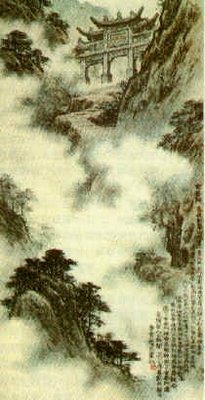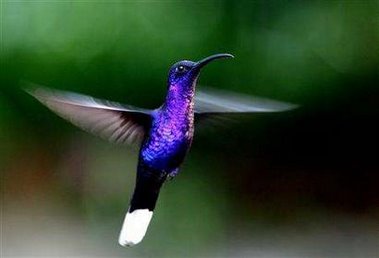
If you click on the title of this post, you'll be directed to the original article, which contains some pictures.
The Boundless Road Is Narrow and Far
Memories of Zhang Yefei, Disciple of Zhang San Feng Taijiquan
by Feng Wu (translated by Chen Bi)
A rich monk and a poor monk were good friends. One day, the poor monk told the rich one, "I want to roam all over the world." The rich one had wanted to do that for many years, but he wasn't mature enough to be ready yet.
Hearing the poor monk's words, he asked, "What will you rely on for roaming?" The poor monk replied, "A cassock to keep warm, a crutch and an earthen bowl. That's enough." The rich monk was surprised and doubted his words. Ten years passed; the poor monk
succeeded in roaming the world. The rich one was ashamed of never having accomplished such a feat.
This old story shows that success is based not only on conditions but one's ambition. As the expressive phrase goes, "Where there is a will there is a way."
My friend Zhang Yefei had such ambitions in the martial arts. He was often teased as a child, which motivated his study. His grandfather had been a lord, and although the political stigma should have ended with his elder, it still affected Zhang. His parents
were both honest, so whenever their children were assaulted, the parents directed them to avoid the bullies. Unfortunately, avoidance was not always possible, so they were bound to take occasional beatings.
The idea of studying martial arts came gradually to Zhang. At the very beginning, without a teacher, he often ran into the woods to kick and hit ! the trees. The bark broke with his strikes, which caught the attention of a famous Ziranmen master, Wan
Laishen. Eventually Zhang knelt before Wan, knocked his head on the ground, and took vows to become Wan's disciple. But shortly thereafter his elder brother got married, which forced him to return home to take care of his family.
Zhang Ye Fei's family was of low status. He had to work hard to earn a living like the
other villagers. He did manual labor in 1994 in Shenyang City. Throughout these hard years, martial arts became part of his life. Indeed, it became his very heart's blood. The purpose for martial arts was not just for self defense. It was much more.
In his spare time, Zhang often visited teachers and friends, determined to research the essence of martial arts. He had the opportunity to meet the great master Li, descendant of another branch of Ziranmen, who was a private folk master. Zhang's understanding of
Ziranmen deepened. He also studied anticlastic-joint-wrestling from another teacher. And
he met his future wife, who shared his love of martial arts. Together, they took to the road to seek the essence of martial arts.
One day, Zhang was doing his regular morning exercises when he saw a middle-aged man practicing some martial arts. He had never seen such a style before and sensed
that it must be very special, since it had no set or regular postures. Was it still a kind of martial arts?
He consulted Master Li, who was with him at the time. Master Li would only say, "He is a master-hand."
A master-hand? Zhang was curious, so he moved closer to investigate. The master discerned his intention and asked, "Do you want to have a try?"
Zhang replied, "How to try?"
"You may hit me," he said. Curious, Zhang tried his best. Though time and again his fists almost reached the master's body, none ever landed! The master's fists answered back, stopping just short of vulnerable points, especially Zhang's face. It was like a man
playing with a child.
In all his years of actual combat experience, Zhang had never encountered anything like this. In those years, he had seen a great many "personalities," but this was the first
person - with the exception of Master Wan Laishen - whose kung fu was truly mysterious. But unlike Master Wan, this man was unknown amongst martial circles. He
had never heard of him.
Feeling lucky to have met such an expert, Zhang was eager to study under him. He could barely contain his excitement when he asked the master to teach him. The master replied with an unconcerned tone, "I have never taken any apprentices. There are so many teachers here. What's it matter who you learn from?"
"Your's is practical," Zhang insisted.
"Practical? Do you mean fighting?" asked the master.
Zhang nodded.
"One needs no study for fighting," replied the master. "Like riding a bicycle, over long periods of time, one can ride it naturally."
Zhang persisted, though his requests for discipleship were denied.
The master was Zhao Zhenjiang, and what he practiced was Zhang San Feng Taijiquan, a style very different from any other kind of popular Taijiquan. According to what Master Zhao said, this style of Taiji was handed down to his ancestors by Zhang San Feng, the
originator of Taiji (thus the name). Passed down within the Zhao family, it was never shared with other clans, perhaps out of strict conservation. "Should not be passed to other families" and "Should not be lost" were the ironclad rules of the Zhang family.
Zhang Yefei stayed in contact with Master Zhao, and they later became friends. During those days, Zhang saw another famous Taijiquan master who often implored Master Zhao to teach his arts, but Zhao politely refused. According to Zhao, even though they were
friends, the ancestor's rule could not be broken.
Once, an affluent martial arts aficionado visited Zhao with a huge amount of money in hand and kneeled down to beg to be accepted as a disciple. Zhao at first denied any knowledge of martial arts, but the would-be student wasn't fooled. He continued to kneel and said that if the master wouldn't accept him, he would kneel forever. Hearing this, Zhao shouted at him, "This is my ancestor's rule! It is useless, no matter how long
you kneel."
Over a year later, Master Zhao began discussing kung fu with Zhang Yefei, but only in reference to what Zhang had practiced. He asked which was good and which was bad. When delighted, he would talk a lot, but when unhappy, he said little. Another year passed, and Zhao finally began to talk about his own boxing style. It was called Zhang San Feng Taijiquan, Wu-style Taijiquan, Taiji Long Quan and Taiji Sanshou. But he
pointed out that Zhang's Wu-style was different than the typical Wu-style Taiji.
Of the five major Taiji styles, the name Wu is derived from the surname of its founder, but the Zhang family Wu means "force" or "strength." His Taiji Long Quan required acts that followed up with sticking, attaching and circling naturally. Taiji Sanshou meant boxing skills with no fixed series or sets. This style had a special method of practice. Zhang sensed that Master Zhao was dropping hints that he might teach him.
But Zhao's temper was something like an old, naughty boy. He was seldom serious in his talk or his teaching of kung fu. In the beginning, he would often quote some pithy martial arts saying, such as, "Taiji is combined with yin and yang - the two each has six. Five methods mix together to be thirteen methods."
If Zhang didn't quite catch what Zhao said, Zhao wouldn't repeat any more. Master Zhao only explained the contents if Zhang was clear on what he said. Zhang habitually listened very carefully to every word from Master Zhao. Over a long period of time, Zhang could
remember nine out of the ten words rushed from Master Zhao's lips.
"Practicing martial arts is a simple thing essentially, that is to develop something you already have," Master Zhao often said. Zhang came to realize this deeply. After more than a year of study, Master Zhao told Zhang, "What I know has taught you... almost. You should go about outside."
He suggested that they visit some teachers and friends. Master Zhao discussed his own experiments. He said that, as a child, he had felt he should learn from some other
teachers that were good at martial arts. He remembered seeing his father practice and thinking that the style was just so ordinary. His father never told him about
those arts at all. He never asked either, and never thought of learning from his father.
When nearly twenty years old, he was rather familiar with what he had studied. Once, he was practicing as his father watched. After finishing, his father said, "It is no use." Zhao was shocked and had a try at his father.
When he did, his father stretched out his hand and his fingers were ready to prick his son's head. Only then did he realize that the martial arts of his family were so good. He also understood why his father had not taught him yet. His father wanted him to enlarge
his perspective by learning from others.
Ever after, Zhao devoted himself to his family style. Zhao said, "You can come back if you still feel my martial art is the best...after five years."
Being poor, it was hard for Zhang to last those five years, but he struggled to follow his master's directions. He and his wife did some odd jobs to stay fed, and now they had a child. The money they earned never seemed to make ends meet. All the while, Zhang
visited teachers and friends, roaming over much of China. What's more, good and bad "experts" in wushu were intermingled, so while he met many good masters, there was a lot of bad too.
With the constant ups and down, his martial skill had gradually matured.
I first met Zhang Yefei in 1999. He and his wife took their three-year-old child to Fuzhou. They lived in a poor house. Their child was ill. All their money was draining away and they were looking for work.
Five years have passed already. Master Zhao Zhenjiang taught them Zhang San Feng Taijiquan by the numbers and permitted them to teach it to others. But this was just the beginning. Zhang Yefei has many ideas. He feels it's not enough to only inherit the method; he should develop it as well, for the fighting arena. He hopes to bring up some students to win the championship titles at an arena near him. The traditional system of Zhang San Feng Taijiquan is not suited for the nation today. Now he wants to evolve it
so that it can be practiced by all the masses and all ages. Though Zhang Yefei has a long way to go, he is following his convictions.
About Feng Wu (translated by Chen Bi):
The author Feng Wu is a martial arts master of China. In recent years, he has devoted himself to researching the theories of traditional martial arts and excavating and classifying the folk tradition styles.
He has written dozens of other articles on both internal and external styles. Master Feng can be contacted at chen09333@sina.com
http://ezine.kungfumagazine.com/ezine/article.php?article=596












